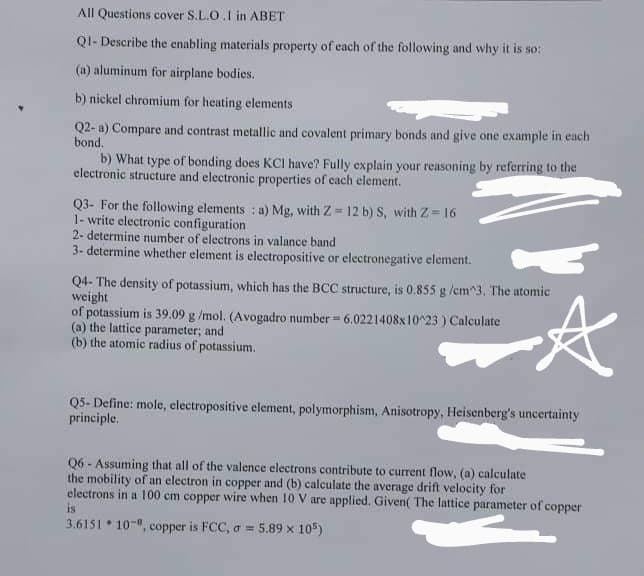Q3- For the following elements: a) Mg, with Z=12 b) S, with Z=16 1-write electronic configuration 2-determine number of electrons in valance band 3- determine whether element is electropositive or electronegative element.
Q3- For the following elements: a) Mg, with Z=12 b) S, with Z=16 1-write electronic configuration 2-determine number of electrons in valance band 3- determine whether element is electropositive or electronegative element.
Principles of Modern Chemistry
8th Edition
ISBN:9781305079113
Author:David W. Oxtoby, H. Pat Gillis, Laurie J. Butler
Publisher:David W. Oxtoby, H. Pat Gillis, Laurie J. Butler
Chapter3: Atomic Shells And Classical Models Of Chemical Bonding
Section: Chapter Questions
Problem 86AP
Related questions
Question
Q3- For the following elements: a) Mg, with Z=12 b) S, with Z=16
1-write electronic configuration
2-determine number of electrons in valance band 3- determine whether element is electropositive or electronegative element.

Transcribed Image Text:All Questions cover S.L.O.I in ABET
QI- Describe the enabling materials property of each of the following and why it is so:
(a) aluminum for airplane bodies.
b) nickel chromium for heating elements
Q2- a) Compare and contrast metallic and covalent primary bonds and give one example in each
bond.
b) What type of bonding does KCI have? Fully explain your reasoning by referring to the
electronic structure and electronic properties of each element.
Q3- For the following elements : a) Mg, with Z = 12 b) S, with Z= 16
1- write electronic configuration
2- determine number of electrons in valance band
3- determine whether element is electropositive or electronegative element.
Q4- The density of potassium, which has the BCC structure, is 0.855 g /cm^3. The atomic
weight
of potassium is 39.09 g /mol. (Avogadro number = 6.0221408x10^23 ) Calculate
(a) the lattice parameter; and
(b) the atomic radius of potassium.
Q5- Define: mole, electropositive element, polymorphism, Anisotropy, Heisenberg's uncertainty
principle.
Q6 - Assuming that all of the valence electrons contribute to current flow, (a) calculate
the mobility of an electron in copper and (b) calculate the average drift velocity for
electrons in a 100 cm copper wire when 10 V are applied. Given( The lattice parameter of copper
is
3.6151 10-", copper is FCC, o = 5.89 x 105)
Expert Solution
This question has been solved!
Explore an expertly crafted, step-by-step solution for a thorough understanding of key concepts.
Step by step
Solved in 2 steps

Knowledge Booster
Learn more about
Need a deep-dive on the concept behind this application? Look no further. Learn more about this topic, chemistry and related others by exploring similar questions and additional content below.Recommended textbooks for you

Principles of Modern Chemistry
Chemistry
ISBN:
9781305079113
Author:
David W. Oxtoby, H. Pat Gillis, Laurie J. Butler
Publisher:
Cengage Learning

Chemistry: The Molecular Science
Chemistry
ISBN:
9781285199047
Author:
John W. Moore, Conrad L. Stanitski
Publisher:
Cengage Learning

Introductory Chemistry: An Active Learning Approa…
Chemistry
ISBN:
9781305079250
Author:
Mark S. Cracolice, Ed Peters
Publisher:
Cengage Learning

Principles of Modern Chemistry
Chemistry
ISBN:
9781305079113
Author:
David W. Oxtoby, H. Pat Gillis, Laurie J. Butler
Publisher:
Cengage Learning

Chemistry: The Molecular Science
Chemistry
ISBN:
9781285199047
Author:
John W. Moore, Conrad L. Stanitski
Publisher:
Cengage Learning

Introductory Chemistry: An Active Learning Approa…
Chemistry
ISBN:
9781305079250
Author:
Mark S. Cracolice, Ed Peters
Publisher:
Cengage Learning

Chemistry for Engineering Students
Chemistry
ISBN:
9781337398909
Author:
Lawrence S. Brown, Tom Holme
Publisher:
Cengage Learning

Chemistry
Chemistry
ISBN:
9781305957404
Author:
Steven S. Zumdahl, Susan A. Zumdahl, Donald J. DeCoste
Publisher:
Cengage Learning
